Princesse beer (2)
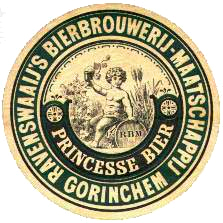 In the last article, we saw how princesse beer first surfaced in Amsterdam in 1748, and that it disappeared around 1900, outcompeted by modern bottom-fermenting beer. And now it’s back, because I found an original recipe which enabled brewers to produce it again. And… you can make it yourself.
In the last article, we saw how princesse beer first surfaced in Amsterdam in 1748, and that it disappeared around 1900, outcompeted by modern bottom-fermenting beer. And now it’s back, because I found an original recipe which enabled brewers to produce it again. And… you can make it yourself.
For a long time, this Dutch historic beer was a mystery to me. To begin with, its name: why a ‘princess beer’? If you’d introduce such a beer today, you’d expect it to be pink, with glitters. But apparently, it wasn’t.Princesse beer started out as a luxury beer for the East Indies instead. In 1747, one year before its oldest mention, stadtholder William IV of Orange came to power in the Republic of the Netherlands. He was married to ‘Princess Royal’ Anne of Hannover, daughter of the king of England. And I think that’s where we have to look for the origin of the name. A beer for supporters of the stadtholder, of the House of Orange, that would eventually become the Dutch Royal family.
And what did the beer taste like? The oldest source to say something on the subject is the book De Koopman (‘The Merchant’), issued in 1768 by Gerrit Bom in Amsterdam. In it, the ‘everywhere so renowned’ princesse beer is described as ‘truly a very unhealthy Drink… which to make it colourful and clear has been supplemented and cut with the well-known harmful things.’[1] Cheers… This probably didn’t represent the average drinker’s opinion, judging by its later popularity.
Then there is the colour. Brewer Antonius Parmentier of Bruges called princesse a white beer in 1788 and a Dutch-French dictionary from 1828 also speaks of an ‘espèce de bière blanche’, a sort of white beer.[2] Alkmaar brewer Johannes Wahlen in 1865 described a Pale Ale he tasted as a white beer, ‘of a yellow copper colour or like the princesse beer’. A princesse beer brewed in the Dutch East Indies (now Indonesia) in 1887 was called ‘a white beer type of low alcohol content.’[3]
Aha, so princesse beer was white or pale? Not if an advert of a Weesp brewery in 1859 is anything to go by, because it speaks of ‘brown princesse beer’.[4] Many other adverts in the 1850s and 1860s have ‘brown or princesse beer’ next to a ‘white barley beer’. Ah, so princesse beer was brown, and barley beer (‘gerste’) was pale?
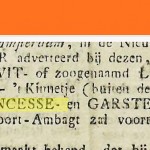 |
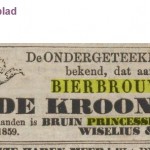 |
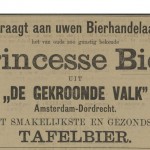 |
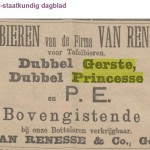 |
Then there are the ingredients. Already in 1816 in Zierikzee there is mention of ‘Princesse and Barley Beer’, and throughout the 19th century we see these two beer types mentioned together.[5] So princesse beer was not made of barley? Yet we see brewer A.F. van Renesse in the city of Gorinchem, who made both types, advertising in 1897 that all his beers are made from first quality barley and hops only.[6] The aforementioned brewer Wahlen wrote of ‘white or Princessen malt’ in 1865 and of ‘malt of barley – white (princess)’ of which he says it is very good to make white beer. He didn’t use it himself because he only made brown beers. So why was princesse beer different from ordinary barley beer? Not because there was a different type of grain in it.
A property mentioned in various sources, was that it was a ‘foaming’ beer, or at least that’s what we read in the Algemeen Handelsblad newspaper in 1883, and in 1889 in Middelburg it is called ‘foaming wonderfully’. Or as a school boy in 1899 declaimed about the princesse beer of the aforementioned Van Renesse from Gorinchem:[7]
‘What joy makes us cheer,
when one can quench one’s thirst
with the delicious foaming beer
of A.F. van Renesse.’
And then there’s the hops used. No source really mentions them, except an interesting flyer issued by the Amsterdam bottling agent P.J.A. Chrispijn in 1889. Despite having to recognise the qualities of lager beer, ‘always crystal clear and leaving no sediment’, he still tried to advertise the ‘Old Dutch princesse’. Even though it could not claim to be ‘crystal clear’, it was still better than lager ‘in terms of flavour and strengthening qualities, because of its higher hop content, which is the most important and best component of the beer’.[8] Hm, interesting.
Still, this is all rather confusing. Luckily there is the book De praktische bierbrouwer (‘The practical beer brewer’) issued in Amsterdam in 1866, which was written by an anonymous Dutch former brewer. This book gives a quite surprising recipe for princesse beer:[9]
PRINCESSE BEER.
For this beer one takes 56 pounds of brown malt, or equal parts of pale and brown malt, according to the colour desired, with 5 ounces [of 100 grams] of Flemish hops, 2 ounces of coriander fruits, 2 ounces of orange peel and 2 ounces of liquorice per tun [of 155 litres]. Evaporation 1/6 part of the quantity of water, yeast 3½ ounce, added to the brew at 12º [Celsius]. Top fermentation.
Brown malt after all, or a mixture of brown and pale malt according to the colour desired? But earlier in the text, the book remarks that for the Dutch beer types, ‘almost every brewer has his own method of preparation.’ This version is not heavily hopped: it’s one of the least-hopped beers in the book. The main feature that distinguishes princesse beer from barley beer here, is its use of coriander, orange peel and liquorice, because the barley beer made from pale malt doesn’t contain all that.
 So if this recipe is anything to go by, a long standing mystery has been solved: princesse beer was a spiced, dark, less hopped version of barley beer. That is, if it wasn’t pale and/or hopped after all, or made of barley and hops only, like in other sources. The above is therefore not the recipe, but a recipe.
So if this recipe is anything to go by, a long standing mystery has been solved: princesse beer was a spiced, dark, less hopped version of barley beer. That is, if it wasn’t pale and/or hopped after all, or made of barley and hops only, like in other sources. The above is therefore not the recipe, but a recipe.
As said, princesse beer silently disappeared from the market around the year 1900. Except, as far as I know, for one place: the city of Gorinchem. In this nice old town by the Merwede river, the local bottom-fermenting brewer had to close because of the grain shortage of World War One, but the top-fermenting Van Renesse brewery mentioned above merrily continued to produce princesse, barley and double barley beer, among others. Around 1925 sales slacked, which the management naturally blamed on the popularity of ‘light beer’ or lager. The company was sold and brewing stopped in 1933. In 1935 there was still a ‘princesse first class’ on sale, brewed for Van 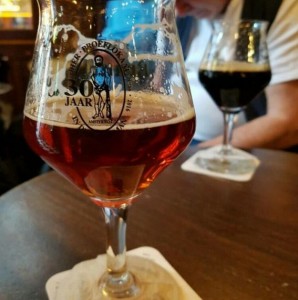 Renesse for another brewery. After that, princesse was a lost beer for good.[10]
Renesse for another brewery. After that, princesse was a lost beer for good.[10]
But not for long anymore! In April 2016, the Anchor Brewery in San Francisco made a one-off princesse beer for the 30th anniversary of the legendary pub In de Wildeman in Amsterdam. Okay, they decided to add anise as well, which gave, er… interesting results. Moreover, princesse beer is returning to the Dutch market, nay the world market, because the once-famous Oranjeboom brand is being revived. Formerly Rotterdam’s most famous brewery, they are now based in Breda. After decades of selling lager to every country imaginable, they are now starting a new range of their old beers. 
 Oranjeboom Princesse and its sister Witte Princesse will be hitting the stores very soon, based on my research and historical advice. Finally my research is paying off for everyone!
Oranjeboom Princesse and its sister Witte Princesse will be hitting the stores very soon, based on my research and historical advice. Finally my research is paying off for everyone!
Want to give it a go yourself? Here is a modern reworking of the recipe. For the ‘brown malt’ in the original, I take Munich malt (English brown malt is too dark, it contains not enough enzymes to get the sugar formation started). I replaced the Flemish malt with Hallertau. If necessary, tweak the amounts to get the right gravity. Don’t be shy with the spices, it’s supposed to have a nice spicy flavour. Just don’t add anise…[11]
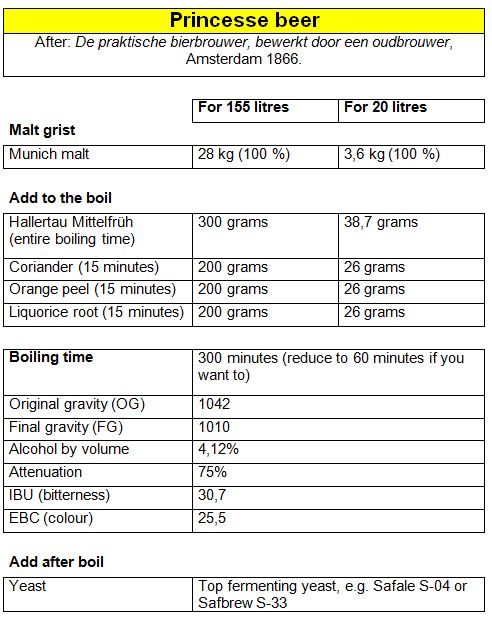
[1] De Koopman, of bydragen ten opbouw van Neêrlands koophandel en zeevaard, Amsterdam 1768, p. 244.
[2] Gendsche Gazette 1-12-1788; P. Weiland and G.N. Landré, Nieuw hand-woordenboek der Nederduitsche en Fransche talen, Den Haag/Amsterdam 1828.
[3] Johannes Wahlen, Brouw-boek, manuscript held at Regional Archives of Alkmaar; De Indische Gids 1887, p. 1932.
[4] Algemeen Handelsblad 19-7-1859.
[5] Zierikzeesche courant 2-4-1816.
[6] Nieuwsblad voor het Land van Heusden en Altena 10-2-1897.
[7] Algemeen handelsblad 11-2-1883, Middelburgsche Courant 15-4-1889, Nieuwe Gorinchemsche Courant 16-2-1899.
[8] Folder issued by P.J.A. Chrispijn ca. 1889, Archive Van Vollenhoven at the City Archive Amsterdam.
[9] De praktische bierbrouwer, bewerkt door een oudbrouwer, Amsterdam 1866, p. 107.
[10] Cf. Nieuwsblad voor Gorinchem en omstreken 26-7-1961, De 5 Rivieren 31-5-1935.
[11] This article was based on an earlier version in Dutch, http://verlorenbieren.nl/verloren-bieren-49-princessebier-2/.






Roel,
I’ve brewed a slight variation of this recently. I used 1oz wacht of licorice root, coriander seed, and bitter orange peel in the last 5 minutes of a 5 gallon batch. Difference is that I added the zest of about 5 mandarin peels to the final beer. This may have been a bit much, but it made for a very satisfying brew that has a fresh and zippy character with a complex and intriguing spice tone in the mid range and aftertaste
Congratulations for all of your research and information. It will be a pleasure to produce a princesse beer in Brasil in our microbrewery .